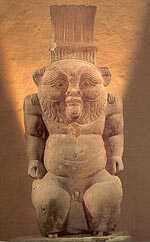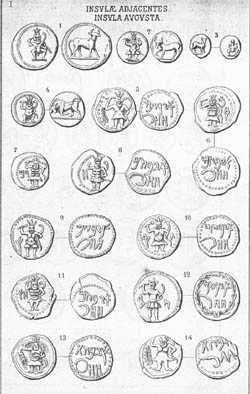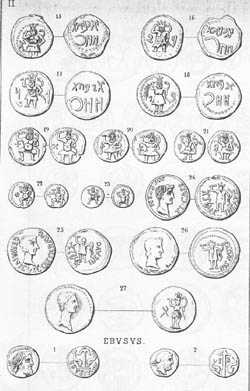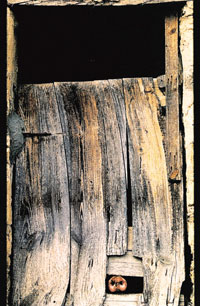| |||||||||||||||||||||||||||||||||||||||||||||||||||||||||||||||||||||
| | |||||||||||||||||||||||||||||||||||||||||||||||||||||||||||||||||||||
Amid the frenzy of gold and donkey-chatter, an earlier discovery at Bahariya has been quietly overlooked, namely the first and only temple dedicated entirely to Bes, unearthed back in 1988. Remember that Bes was popular in ancient Egypt for at least two millennia (and in the Phoenician-Punic world for not much less) it is really quite remarkable that no temple dedicated to him had previously come to light. But wait a minute: in ancient Bithia on Sardinia’s southern coastline, the recovery of a two-and-a-half foot sandstone Bes led Italian archaeologists to talk of a temple there, even if the one at Bahariya is the first to be fully-accredited. The Egyptian sanctuary contains what is probably the finest statue of the dwarf-god ever found; four feet high with traces of the original paint (see illustration above). It is time once again to step onto our magic library carpet and it so happens that today’s destination is the home state of Indiana Jones himself. Shelli Wright Johnson’s The Story of Bes (2000) opens just a few miles from the shores of Lake Michigan in the gabled attic of an old farmhouse. While little Andy’s parents are going through the worldly goods of his recently-deceased grandma down below, their inquisitive nine-year-old and his trusty terrier are picking their way through the weird and wonderful objects stored for generations out of sight and mind. Among them is great-great grandpa Horace’s old wooden box from Egypt containing a roll of tattered and crumbling ‘paper’. Andy is puzzling over its strange squiggles when Max starts growling at a strange creature lurking in a corner:
Of course not! Our local Indiana hero has unwittingly pipped the dwarf-god to the post, the papyrus being a vital document the latter has been chasing over the previous two thousand years. But after a brief session of magical harp-playing the two become bosom pals and treasure-hunting gives way to a tutorial on Egyptian mythology. Bes proudly explains his role in the saga of Osiris, assisting in the birth of falcon-headed Horus (Horace, geddit?). I am delighted to say that Byblos (see Part Seventeen in Weekly Edition 083 Saturday 28th September 2002), where Osiris’s coffin-like casket was washed ashore, gets an honorary mention. A welcome change of pace comes in the second half of the tale, set in real time (i.e. ancient Egypt) as Andy’s endless interruptions - like the omnipresent italics - will grate on most nerves. After slaying a gigantic sea-serpent and a fearsome crocodile, Bes leads Isis out of a fifty-day sandstorm into a quiet cave where the latter gives birth to Horus. At this point Andy’s father interrupts the narrative with the news that Mom is about to give birth prematurely. An invisible Bes does his childbirth protective act in the local hospital’s Emergency Room and all turns out well. Before taking his leave at the farm, Bes assures Andy that there are many more stories to tell - how he protected young Horus during childhood and trained the god for the ultimate showdown with evil Uncle Set (like Disney’s The Lion King). Before The Story of Bes, Part Two rolls off the presses, I do hope someone has a quiet word with the author and her editor about italics. The discovery of Tanit’s sanctuary in San Vicente came about thanks to a shepherd-boy who was searching for a lost goat - or so the story goes; the sanctuary at Bithia came to light in 1930 after a sea-storm swept away part of the neighbouring coastline; then there is the conventional shrine-detector mentioned above - a donkey or mule. So what can be done to increase the chances of finding Bes’s Pityusan fastness? I would put money on it being either in an extremely obvious place, or else in an extraordinarily remote one: either at the top of Dalt Vila (underneath the citadel, currently being excavated) or at the opposite end of the island from Tanit - the steep escarpments overlooking Cala d’Hort. The view across to Es Vedrà would provide a neat mirror image of the view to Tagomago from the rocky platform in front of Es Cuieram. If the cult of Phoenician-Egyptian Bes arrived in Ibiza before that of Carthaginian Tanit, then his priests would surely have appropriated the site with the best view. Is there anywhere else in the Mediterranean that can hold a candle to it? Well yes, there is a third possibility: the Illa Plana just beyond Marina Botafoc was first excavated in 1907-8, yielding a large number of strange curviform figurines over which at least three generations of archaeologists have been scratching their heads. They have been called Cypriot, for want of a better label, but could they perhaps have something to do with the forgotten cult of Bes? And might not the original statue whose image was reproduced on Ibiza’s Carthaginian coins be lying just under the surface - to which a complicating layer of closely-packed chalets has just been added? So Mystery-Hunters, why squander hard-earned royalties digging for imaginary halls beneath the Giza Plateau or the Yucatan shelf? Just two months ago a group of Italian archaeologists announced the discovery of a large statue of the Carthaginian fertility god Baal-Addir and an unusual polychromatic Egyptian relief (ca. 425 BC) in a painted underground chamber in Sulcis, southern Sardinia. The White Island too is calling. Don’t forget to bring the donkey.
Martin
Davies |
| | |||||||||||||||||||||||||||||||||||||||||||||||||||||||||||||||||||
| |||||||||||||||||||||||||||||||||||||||||||||||||||||||||||||||||||||




